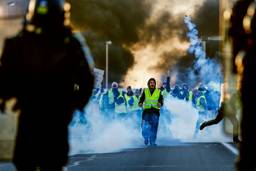“This Will Have a Ripple Effect Across the Country”: State of New York Bans Fracking
After years of pushing in New York, environmental activists have finally chalked up a victory against hydraulic fracturing.
Cole Stangler

Six years after public opposition began to mount, the state of New York is moving to prohibit hydraulic fracturing, or “fracking” — the controversial drilling practice that involves blasting apart shale rock formations with chemicals and water in order to access oil and natural gas deposits.
“I cannot support high-volume hydraulic fracturing in the great state of New York,” Health Commissioner Howard Zucker announced at a Wednesday cabinet meeting alongside Governor Andrew Cuomo. Moments later, the state’s environmental chief Joseph Martens said he would issue a legally binding recommendation to prohibit fracking.
Once finalized, the outright ban will replace the state’s de-facto moratorium, in place since 2009, marking the end of one of the longest, most politically heated debates on the subject in the nation. In the end, Zucker said the lack of scientific knowledge on the long-term public health impact of fracking makes the drilling technique unsafe.
“I think the process that the governor used to get there was tortured, to say the least,” says Bruce Ferguson, an activist with Catskill Citizens for Safe Energy, based in Sullivan County. But eventually, the administration “did follow the trail of scientific evidence and came to the right conclusion.”
After years of calling for a ban and encouraging towns to pass their own bans, activists are celebrating the landmark decision. Vermont passed a fracking ban in 2012, but New York is the first state with significant gas deposits to prohibit the practice.
“When I got involved in this in the spring of 2008, there were just a handful of people working on the issue,” Ferguson says. “If there had not been this tremendous outpouring of grassroots support since 2008, there’s no question that New York would [have been] fracked for years now.”
Crucial, too, was the activist role of medical professionals. The New York State Medical Society, the American Lung Association in New York and the American Academy of Pediatrics all raised concerns as the state conducted its long-term public health study, which began in September 2012. The health-focused logic behind the forthcoming ban stands in stark contrast to the regulate-as-you-go method followed by most states.
“Many states across the country went ahead and fracked before understanding what the potential health effects would be and really subjected the people living in the states to a large public health experiment, like guinea pigs,” says Emily Wurth, water program director at Food & Water Watch, the nation’s biggest anti-fracking group. “It’s refreshing to see the state of New York take a much more precautionary approach to protect public health and the environment.”
Other political and economic factors were at play, too. The Cuomo administration faced increasingly visible opposition from the Left over its perceived “stalling” on the issue: Cuomo’s underdog challengers in September’s primary and November’s general election—Zephyr Teachout and Howie Hawkins, respectively — campaigned heavily on an anti-fracking message and both performed surprisingly well. Moreover, with falling oil and natural gas prices, the potential economic benefits of drilling are not as pronounced as they once were.
The nation’s two biggest oil and gas lobbying groups, the American Petroleum Institute and America’s Natural Gas Alliance, expressed dismay over the decision.
Empire State regulators are challenging a powerful narrative from industry — the idea that anti-fracking activists are essentially emotionally driven, anti-science quacks.
“You’ve had the EPA head calling hydraulic fracturing completely safe, and if it’s good enough for the experts at the top of the Obama administration, it seems strange that the New York Department of Health would have a problem with this,” says Julia Bell, spokesperson for the Independent Petroleum Association of America, another industry trade group.
Activists say the decision will strengthen efforts to rein in the drilling practice nationwide.
“This will have a ripple effect across the country,” says Emily Wurth at Food and Water Watch. “It will really embolden the growing national movement against fracking.”
Two liberal-leaning states, in particular, face heated battles over fracking. In Maryland, outgoing Governor Martin O’Malley just put an end to the state’s de-facto moratorium, releasing a set of supposedly responsible “best practices” for drilling. But activists are hoping to convince the state’s veto-proof Democratic majority legislature to pass an outright ban. Meanwhile, in California, Governor Jerry Brown is facing similar demands from green groups.
Polls have shown the American public increasingly opposes fracking. But Cuomo’s decision marks the clearest shift in actual political power toward activists bent on stopping such drilling.
“When the initial moratorium passed here, that had national and international reverberations,” says Renee Vogelsang, upstate regional director of New Yorkers Against Fracking. “The same thing’s going to happen today.”








